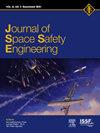利用生物修复法对 "联盟号 "运载火箭使用的碳氢化合物火箭燃料污染土壤进行解毒
IF 1.7
Q3 ENGINEERING, AEROSPACE
引用次数: 0
摘要
全世界都在发展火箭和空间活动,但在追求新技术时忽视了环境问题。哈萨克斯坦共和国的“拜科努尔”航天发射场经常在紧急情况下发射火箭,造成有毒燃料溢出并污染土壤。本研究在实验室条件下考察了T-1煤油(一种有毒危害等级为4的碳氢化合物火箭燃料)对曝气区土壤微生物群落的影响。在三种不同的土壤样品中,根据微生物在3天、10天和30天内的利用情况,测试了15 g/kg、30 g/kg和50 g/kg的T-1煤油。根据科学研究,几种微生物能够利用T-1煤油火箭燃料,如钙醋酸不动杆菌-18、芽孢杆菌sp.-20、玫瑰微球菌-25和念珠菌sp.-12/5,纯化率为70%至90%。在初始负荷为50 g/kg T-1煤油的条件下,对钙化醇(loamic)(第196个位点)和难降解油砂(第31个位点)进行了30天的微生物解毒研究,确定了浓度。产5+ 20(99.83%)和18+20+25+12/5(99.80%)油品的微生物得到了很好的利用。在去污过程中,被碳氢化合物污染的土壤在60天后被发现存在于土壤中,当微生物№20以9.3 mg/kg使用时,微生物5 + 25的关联为8.88 mg/kg。本文介绍了利用微生物法进行土壤脱毒的最新技术。本文章由计算机程序翻译,如有差异,请以英文原文为准。
Detoxification of contaminated soils from hydrocarbon rocket fuel used in «Soyuz» launch vehicles using the bioremediation method
Rocket and space activities are developing worldwide, but environmental concerns are overlooked in pursuing new technologies. The Republic of Kazakhstan's "Baikonur" Cosmodrome routinely launches rockets in emergencies, causing toxic fuel to spill onto and contaminate the soil. This study examines the effect of T-1 kerosene, a hydrocarbon rocket fuel of toxic hazard class 4, on the soil microbial community from the aeration zone in laboratory conditions. In three different soil samples, 15 g/kg, 30 g/kg, and 50 g/kg of T-1 kerosene were tested according to their utilization by microbes throughout three, ten, and thirty days.
Based on scientific research, several strains of microorganisms were able to utilize T-1 kerosene rocket fuel, such as Acinetobacter calcoaceticum-18, Bacillus sp.-20, Micrococcus roseus-25, and Candida sp.-12/5, purifying it from 70 to 90 %. According to a study conducted after 30 days of microbiological detoxification of calcisols (loamic) (site 196) and dystric arenosols (site 31), with an initial load of 50 g/kg of T-1 kerosene, the concentration was determined. Microorganisms that produce 5 + 20 (99.83 %) and 18+20+25+12/5 (99.80 %) oil products are well utilized. During decontamination of soils contaminated with hydrocarbons was found to be present in the soil after 60 days when microorganism № 20 was used at 9.3 mg/kg, and the association of microorganism 5 + 25 at 8.88 mg/kg. The article describes the developed technology for soil detoxification using the microbiological method.
求助全文
通过发布文献求助,成功后即可免费获取论文全文。
去求助
来源期刊

Journal of Space Safety Engineering
Engineering-Safety, Risk, Reliability and Quality
CiteScore
2.50
自引率
0.00%
发文量
80
 求助内容:
求助内容: 应助结果提醒方式:
应助结果提醒方式:


